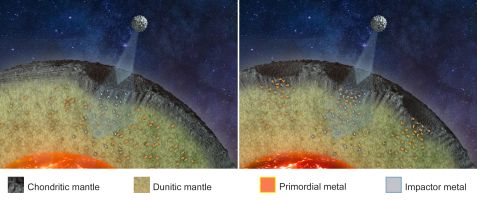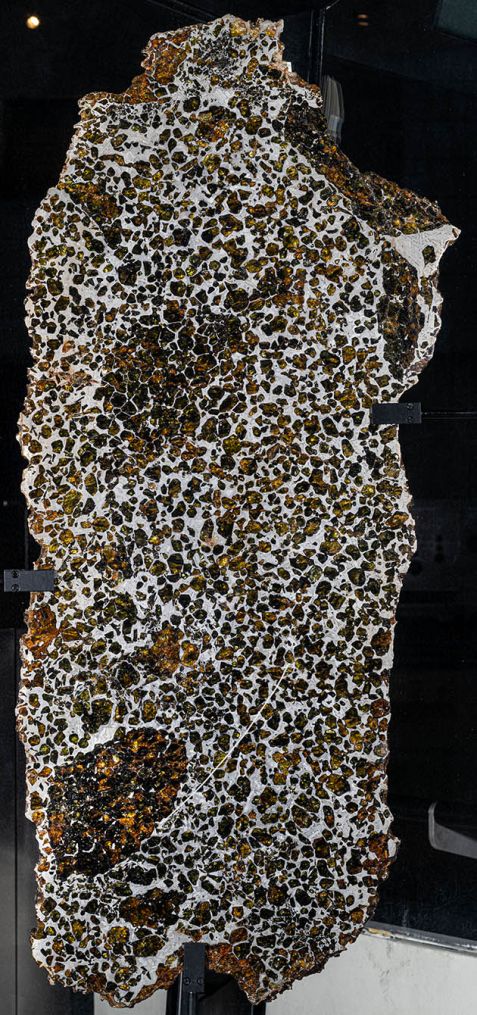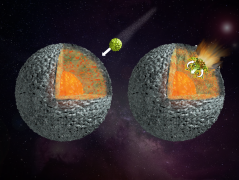MLZ is a cooperation between:
 > Technische Universität München
> Technische Universität München > Helmholtz-Zentrum Hereon
> Helmholtz-Zentrum Hereon
 > Forschungszentrum Jülich
> Forschungszentrum Jülich
MLZ is a member of:
 > LENS
> LENS > ERF-AISBL
> ERF-AISBL
MLZ on social media:

MLZ (eng)
Lichtenbergstr.1
85748 Garching
The origin of everything: exploring the early solar system

Pallasites are most likely formed by collision of two celestial bodies. Conclusions about the parent body can be drawn later. © Reiner Müller
Where did the Earth originate? Why do planets look the way they do? How did the solar system form? These big questions have been driving mankind forward since forever – and the answer is made up of an infinite number of small details. Researchers at the Heinz Maier-Leibniz Research Neutron Source are working to uncover some of these details.
Dr. Nicolas Walte, an instrument scientist at the SAPHiR high-pressure press, has been studying pallasites, a class of rock-iron meteorites, for some time. He first simulated the formation of these cosmic bodies at the SAPHiR high-pressure press. In his new work, Walte and his colleague Prof. Dr. Gregor Golabek of the University of Bayreuth are again studying these particular meteorites. This time, however, the focus is on what must have happened in their parent body before and after their formation.

Almost 1 meter long slice of Esquel pallasite with greenish olivine crystals in gray iron-nickel matrix. The aggregates examined are the roundish areas with coherent olivines. © American Museum of Natural History, Denis Finnin
Support from international museums
For his research, Walte asked various museums for help and had them send him the best photos of their largest and most beautiful pallasites. Among them were images of the four pallasites, Fukang, Imliac, Esquel and Seymchan, from the collections of the National History Museum in London, the University of Arizona, the American Museum of Natural History and the National Museums of Scotland.
Using the high-resolution photos, Walte outlined the olivine aggregates at the so-called grain boundaries, the transition between crystal and metal veins. He compared this internal structure of the meteorites with samples from the SAPHiR high-pressure press to understand their different histories.
“The proportions of primary material show that all pallasites spent one to two million years together at the same temperature.” Collision with another asteroid caused the metal and mineral components of the two celestial bodies to mix, forming the pallasites that later found their way to Earth.
What was before the pallasites?
“We focused on the olivine aggregates this time,” Walte explains. These areas of connected olivine crystals can be up to 30 cm in diameter. “These aggregates are thought to be little-altered samples from inside the parent body. If you understand those, you understand the before,” he continues. Before – that means learning more about the parent body from which the pallasites emerged.
Olivine is the main component of Earth’s upper mantle, but is also commonly found in the mantle of asteroids, astronomical small bodies that orbit the sun and are the remnants of the building blocks of Earth and the other terrestrial planets. Pallasite disks thus allow researchers to draw conclusions about the composition of asteroid mantles. This helps them understand how asteroids formed.
And what happened afterwards?
By comparing the metal veins running through the crystals in the pallasites with deformation experiments on the SAPHiR instrument, it is also possible to tell how quickly or slowly the pallasites cooled after they were formed. Walte explains the differences in cooling times by the fact that the meteorites originate from different depths in the mantle of the parent body.
The researchers can thus get a more precise picture of the composition of the mantle. Among other things, it allows them to estimate the maximum size the asteroid could have been, what kind of celestial body it was exactly.
“The main work was actually the precise tracing of the details on the photos,” Nico Walte admits modestly. In the process, however, he has also helped to shed a little more light on the most important processes that were necessary for the formation of the Earth and other terrestrial planets.
Original publication:
N. Walte, G. Golabek, Olivine aggregates of Main Group Pallasites reveal the early evolution of their Parent Body, Meteorit. Planet. Sci., 57(5), https://doi.org/10.1111/maps.13810, (2022)
More information:
Pallasites belong to the stony-iron meteorites. Characteristic for these beautiful rocks from space are the centimeter-sized embedded olivine crystals, which shimmer greenish between iron and nickel. That is why they are very popular with collectors. They were formed in the early days of the solar system and are one of the few sources that provide information about the mantle of their parent asteroid. Understanding their formation and the processes before and after in more detail allows us to decipher the dynamics of the early solar system.
All four Pallasites studied originated from the same parent body, even though they were found in different locations on Earth. This makes it possible to compare the development of different areas inside the common mother body.
Related News
-
29.07.2020
How stony-iron meteorites form
MLZ is a cooperation between:
 > Technische Universität München
> Technische Universität München > Helmholtz-Zentrum Hereon
> Helmholtz-Zentrum Hereon
 > Forschungszentrum Jülich
> Forschungszentrum Jülich
MLZ is a member of:
 > LENS
> LENS > ERF-AISBL
> ERF-AISBL
MLZ on social media:



